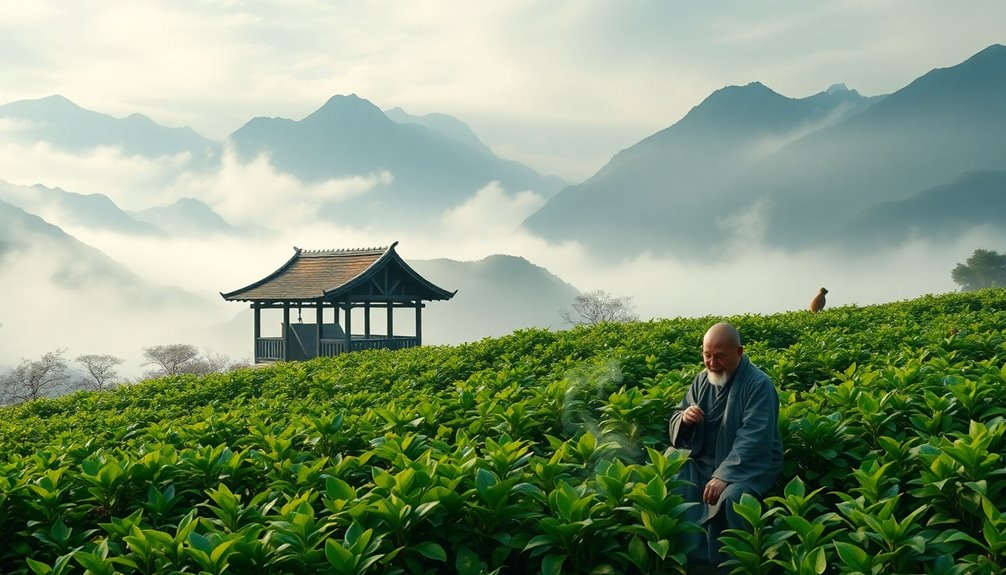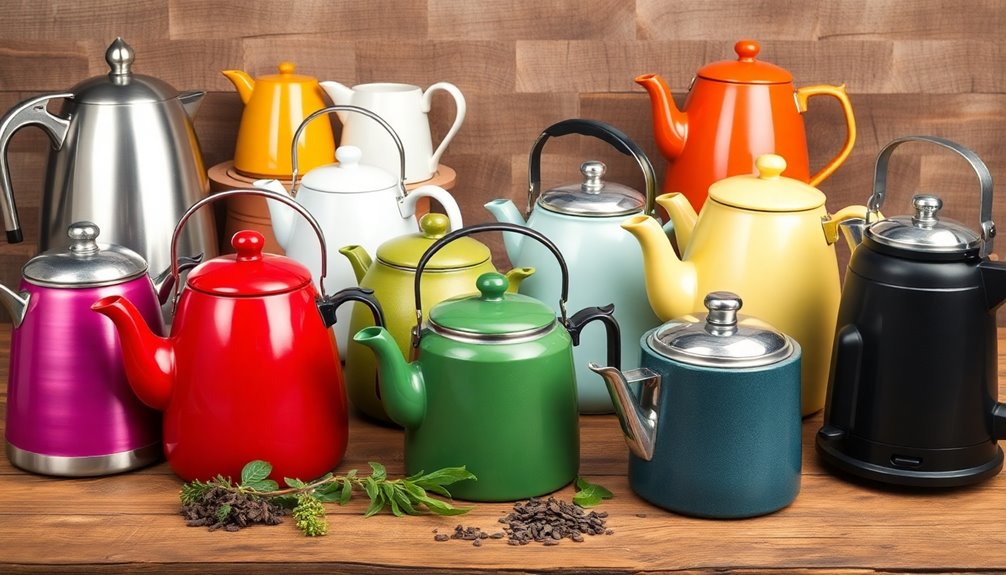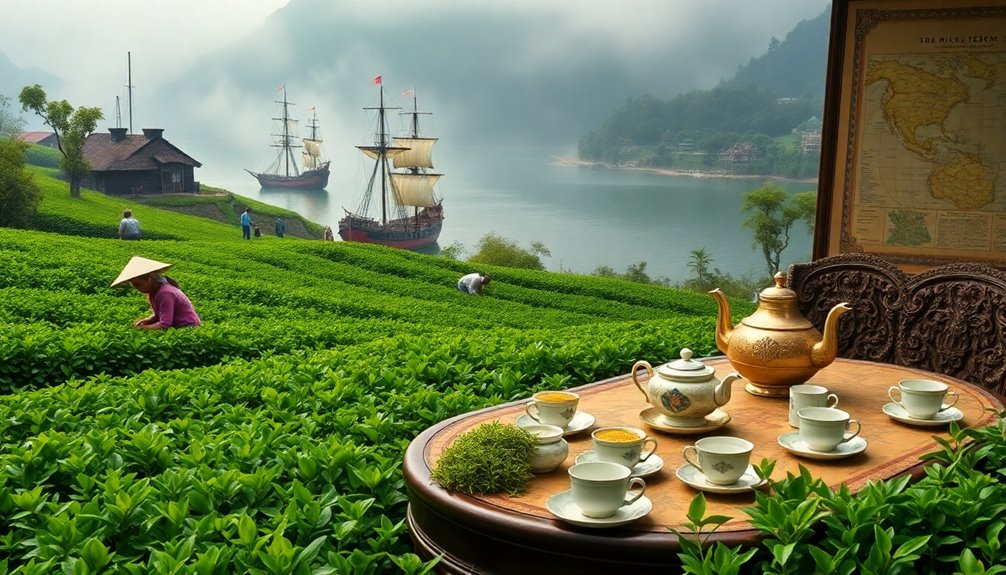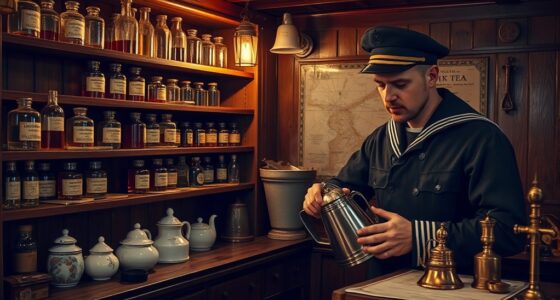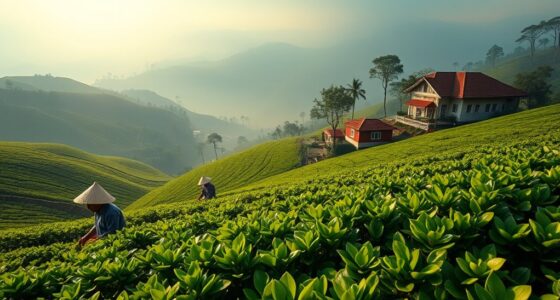The legendary stories behind tea's discovery start with Emperor Shen Nong in 2737 BC. As he boiled water, some leaves accidentally fell in, creating a delightful drink! Initially, people used tea for its healing properties, making it popular for health benefits. Over time, tea became central to cultural rituals, especially during the Tang dynasty, which celebrated this beverage as a national treasure. Today, it's enjoyed worldwide in various forms. You might be curious about how tea spread and transformed societies. Keep exploring to discover how tea not only warmed hearts but also connected cultures!
Key Takeaways
- Emperor Shen Nong discovered tea in 2737 BC while boiling water, accidentally creating a beverage with medicinal properties.
- Initially, tea was used for its calming effects, emphasizing health benefits rather than social consumption.
- The early cultivation of tea began in Yunnan province, China, and spread through trade routes to neighboring regions.
- The Tang dynasty established tea as a national drink, with Lu Yu's "Cha Ching" documenting its types and preparation methods.
- Buddhist monks played a crucial role in introducing tea culture to Japan, integrating it into rituals and social gatherings.
Introduction
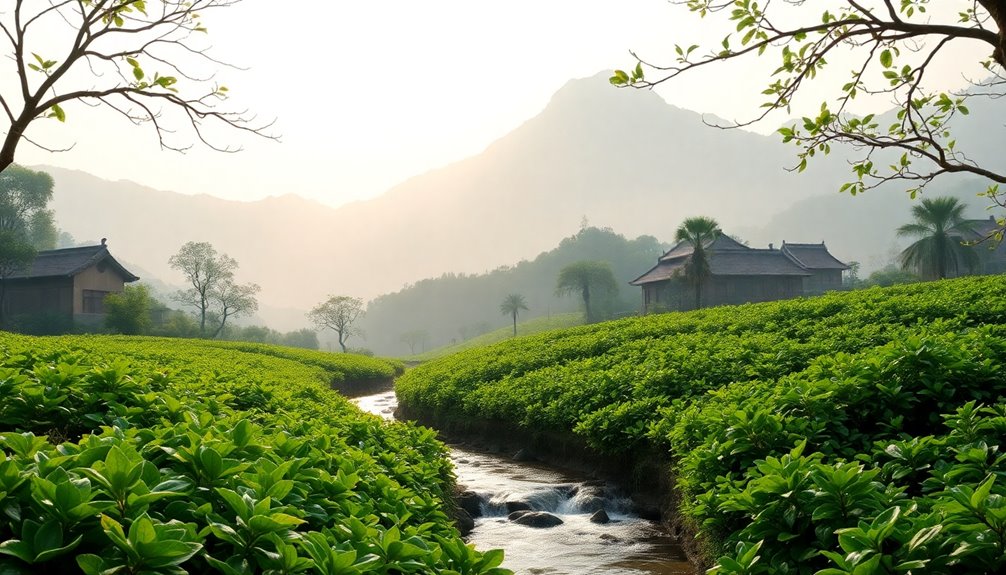
Tea, with its rich history and cultural significance, is more than just a beverage; it's a cornerstone of various traditions around the world.
The legendary discovery of tea dates back to 2737 BC, when Emperor Shen Nong accidentally created this delightful drink. While boiling water, a leaf from a wild tea plant fell in, forever changing Chinese culture. This fortuitous event sparked Shen Nong's exploration of tea and its medicinal properties, leading to tea's importance in daily life and health.
Fast forward to the Tang dynasty (618-907 AD), when tea became a national drink in China. The monk Lu Yu played a key role in its cultural significance through his writings, especially his famous work "Cha Ching," which detailed different tea types and preparation methods.
The influence of tea didn't stop there; Buddhist monks helped spread this cherished drink to Japan, bringing tea seeds and their brewing knowledge. This exchange ultimately led to the development of the Japanese tea ceremony, a beautiful tradition that reflects the deep respect for tea.
Tea's Medicinal Origins in China
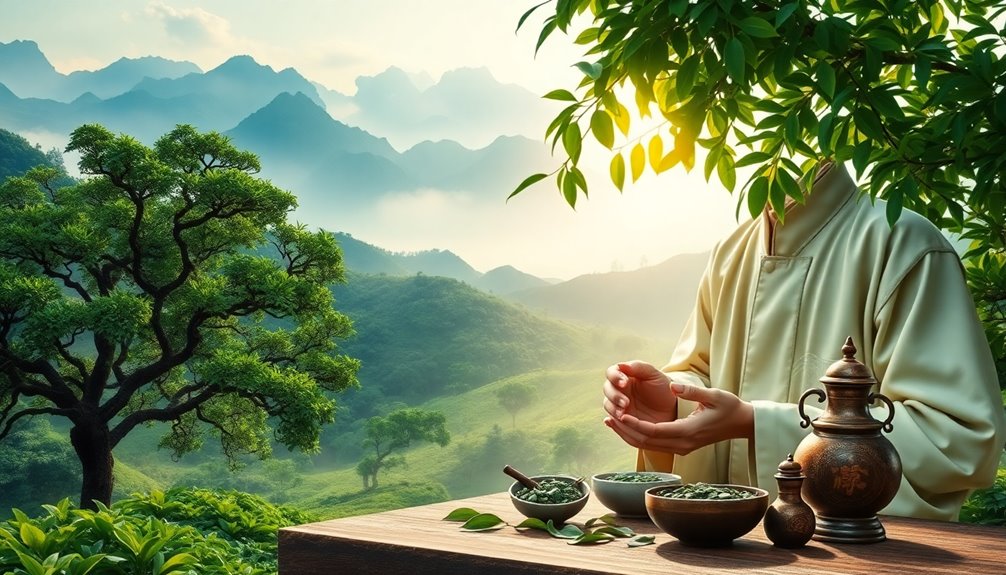
The ancient roots of tea's medicinal origins in China reveal a fascinating journey from a serendipitous discovery to a revered health tonic. According to Chinese legend, Emperor Shen Nong, known as the father of Chinese medicine, stumbled upon tea around 2737 BC when a wild tea leaf accidentally fell into his boiling water. Intrigued, he began researching tea's medicinal properties, highlighting its numerous health benefits. Notably, the calming effects of tea can be enhanced with essential oils like lavender oil, known for its ability to reduce stress levels. Additionally, tea is rich in antioxidants, which may contribute to its health-promoting effects. Drinking tea at the right water temperature can also maximize its beneficial properties. Interestingly, herbal teas like chamomile and peppermint have been noted for their ability to alleviate symptoms of conditions such as fibromyalgia.
During the Han dynasty, tea became a luxury item primarily reserved for the wealthy, serving as a status symbol among nobility. Only the elite enjoyed its soothing qualities, while the common populace had limited access.
However, by the Tang dynasty, things began to change. Government initiatives encouraged the planting of tea bushes and the establishment of tea stores, making it easier for everyone to enjoy tea.
As tea's popularity grew, so did its reputation for healing. People began to appreciate tea not just for its taste but also for its health benefits. Interestingly, studies indicate that certain scents, including those from tea, can reduce cortisol levels, a stress hormone, highlighting the benefits of aromatherapy.
Today, we can thank those early pioneers for introducing us to this delightful beverage that has become a staple in homes around the world.
Medicinal Use Predates Tea Culture
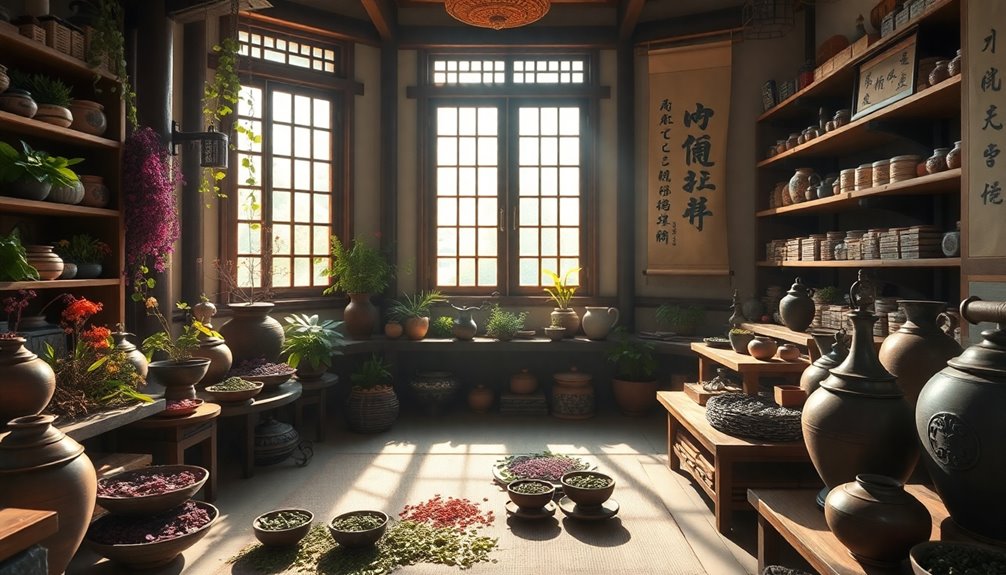
Recognizing tea's medicinal roots in ancient China highlights how its use predates the rich culture surrounding it. The story begins around 2737 BC when a Chinese emperor, Shen Nong, discovered tea's potential as a medicinal beverage. An accidental fall of a tea leaf into his boiling water led to the realization of its health benefits.
Initially, tea was valued for its medicinal use, with ancient texts emphasizing its healing properties rather than its role as a social drink.
During the Han dynasty, tea became a luxury item, enjoyed mostly by the wealthy. This exclusivity kept its medicinal benefits hidden from the everyday person.
It wasn't until the Tang dynasty that tea started to gain popularity among commoners. Government efforts to plant tea plants and open tea shops encouraged broader consumption.
As tea found its way into daily life, its medicinal use laid the foundation for its cultural significance. People began to integrate tea into their routines, recognizing its health benefits while enjoying it as a refreshing beverage.
This shift marked the start of tea's journey from a healing drink to a beloved part of Chinese culture.
Tea's Role in Ancient Rituals

Emerging from its medicinal roots, tea quickly became entwined with ancient rituals in China, serving not just as a beverage but as a medium for spiritual connection and social bonding. The Chinese emperor Shen Nong, curious about tea's health benefits, helped spark its popularity around 2737 BC.
As time went on, tea drinking evolved into a significant part of ancient rituals. During the Tang dynasty, Buddhist monks embraced tea to enhance focus and mindfulness during their meditation sessions. You can imagine how tea became a soothing companion, helping them connect more deeply with their spiritual practices.
In ceremonial settings, tea drinking signified respect and hospitality, especially among nobility and scholars. Cultural practices surrounding tea continued to flourish, leading to the elegant tea ceremony that we know today.
These rituals emphasized harmony, respect, and purity, showcasing tea's importance in social gatherings. The belief in tea's medicinal properties further embedded it into the cultural fabric, promoting health and longevity.
Cultural Appropriation of Tea Traditions
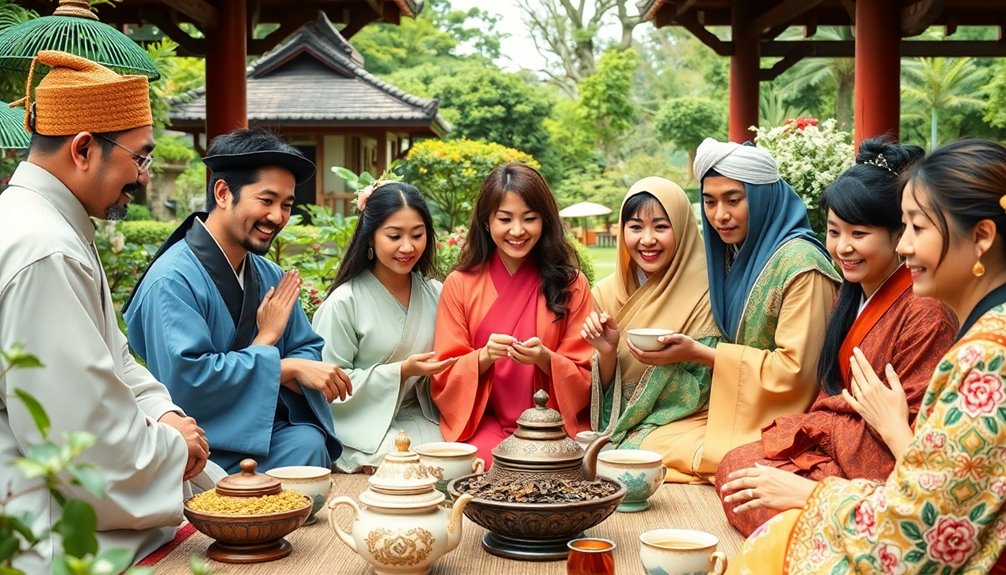
As tea's rich history in ancient rituals continues to influence modern practices, it's important to consider how these traditions are sometimes appropriated in different cultural contexts.
Cultural appropriation of tea traditions can happen when people outside the original cultures adopt elements without understanding their origins and significance.
For instance, the Japanese tea ceremony, known for its deep spiritual meaning, has been simplified into casual tea drinking experiences in the West. This shift often strips away the ceremonial importance.
Similarly, the commercialization of tea has led to trendy items like matcha lattes that cater to Western tastes, neglecting the traditional preparation methods from Japan.
The rise of bubble tea, which originated in Taiwan, shows how different cultures can blend together. However, it also raises questions about ownership and representation in culinary spaces.
To address these issues, educational initiatives are crucial. They help everyone understand the true origins and significance of tea practices, reminding us to honor and respect the traditions from which they come.
Practical Applications

Tea has been utilized in various practical applications throughout history, showcasing its versatility beyond mere enjoyment. Starting as a medicinal beverage, tea was discovered by Emperor Shen Nong in 2737 BC, who valued its health benefits.
Fast forward to the Tang Dynasty, where tea became more accessible to everyone due to government support. This made tea a part of daily life for many people.
In Japan, Buddhist monks introduced tea in the 9th century, leading to the creation of the Japanese tea ceremony. This beautiful tradition emphasizes mindfulness and social harmony, making tea a way to connect with others.
As time went on, the British East India Company made tea widely available in the 17th century, transforming it from a luxury item into a staple drink for many cultures. You might even remember the Boston Tea Party, a significant event tied to tea's political history!
Today, practical uses of tea continue to evolve. The introduction of tea bags in the early 20th century made brewing easier for busy tea drinkers, allowing you to enjoy your favorite sip with just a few simple steps.
Tea truly has a remarkable history that continues to enrich our lives!
Frequently Asked Questions
What Are the Famous Legends About the Discovery of Tea?
You'll find famous legends about tea's discovery, like Emperor Shen Nong's accidental brew and Bodhidharma's meditation aid. These tales highlight tea's cultural significance, intertwining history with tradition, spirituality, and daily life across various regions.
What Is the Story Behind Tea Invention?
Tea originated from a serendipitous encounter with boiling water and a wild leaf. You'd discover its rich flavors and health benefits, leading to its rise as a beloved beverage across cultures and centuries.
How Did Emperor Shennong Discover Tea?
Emperor Shennong discovered tea when a leaf accidentally fell into his boiling water. Intrigued by the aroma and taste, he explored its refreshing qualities, eventually recognizing its potential health benefits and medicinal properties.
What Was the Accidental Invention of Tea?
You might find it fascinating that tea was accidentally invented when a wild leaf fell into boiling water. This surprising moment transformed a simple drink into a cherished cultural staple, highlighting nature's role in discovery.
Conclusion
In conclusion, tea's rich history is full of fascinating stories, from its medicinal beginnings in China to its important role in rituals. As you explore different tea traditions, remember how they connect cultures and bring people together. So, whether you're sipping a warm cup at home or sharing it with friends, you're part of a legendary journey. Enjoy each sip, and let the stories of tea inspire your own celebrations! Happy brewing!

